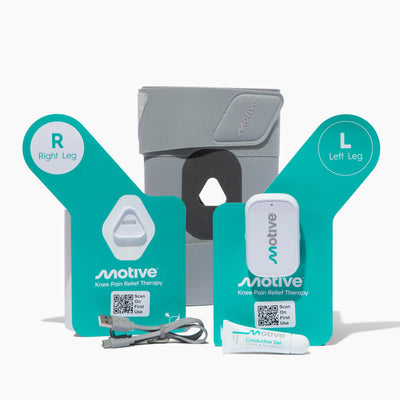
Knee pain is one of the most common complaints among adults, affecting 25% of the population at some point in their lives. Be it osteoarthritis, runner’s knee, or an old injury, knee pain can make daily activities challenging. Even climbing stairs can be a burden. Pain in the knee joint, ligaments, or surrounding muscles can heighten due to common causes such as overuse, muscle imbalances, and aging.
Climbing stairs is one of the toughest activities for those with knee pain as it puts extra stress on the kneecap, thigh bone, and ligaments. Going up and down the stairs requires the leg muscles to work in coordination, including the muscles around the tibia and femur. When these muscles are weak or there is joint misalignment, it can lead to more pain and a higher risk of a knee injury.
In this article, we will look at ways to manage knee pain when climbing stairs. We’ll cover the causes of knee pain, treatment options, exercises to get you mobile, and how Motive can help.
Strategies for Managing Knee Pain When Climbing Stairs
Climbing stairs can be tough when you endure knee pain. Here are some practical ways to make it easier and less painful.
-
Use Handrails for Support: Handrails are your best buddy when it comes to reducing the load on your knees when climbing stairs. By holding onto the handrail, you can offload some of your body weight from your knees to your upper body, making each step less painful and more stable.
-
Take Smaller Steps: Taking smaller, more deliberate steps can help minimize the pressure on your knee joint. By reducing the range of motion, you lessen the strain on your ligaments and muscles, making it easier for you to go up or down stairs.
-
Lead with Your Stronger Leg: If one knee is more painful than the other, start your climb by leading with your stronger leg. When descending, lead with the weaker leg. This way, you can distribute the load more evenly and reduce discomfort.
-
Consider a Knee Brace: A knee brace can give you extra support and stability to your knee joint, especially if you have conditions like patellofemoral pain syndrome or ligament injuries. This can help prevent further injury.
- Avoid Stairs When Necessary: If your knee pain is severe or you’re in the middle of a flare-up, it’s best to avoid stairs altogether. Use the elevator or ramp when possible, and give your knee time to rest and recover.
Effective Exercises for Knee Strength
Strengthening the muscles around your knee joint is key to reducing knee pain when climbing stairs. By focusing on exercises that target the quadriceps, hamstrings and calf muscles, you can improve stability, reduce discomfort and overall mobility.

Source: Jacksonville Orthopadic Institute
Here are some strengthening exercises to help you strengthen these specific muscle groups. Remember to do these exercises with proper form to avoid injury, reduce risk factors, and gradually increase the intensity as you get stronger.
1. Squats
Squats are a form of knee bends that are great for strengthening the quads, hamstrings and glutes which all support the knee joint.
Instructions:
- Stand with your feet shoulder-width apart and toes pointing slightly out.
- Keep your chest up and core engaged.
- Slowly lower your body by bending your knees and hips as if sitting back in a chair. Don’t let your knees extend past your toes.
- Lower down until your thighs are parallel to the ground or as far as you can without discomfort.
- Pause, then push through your heels to get back up.
- Repeat for 10-15 reps, 2-3 sets.
Tip: If you get knee pain during this exercise, try reducing the depth of the squat or doing it with a chair behind you for support.
2. Lunges
Lunges are great for targeting the quads, hamstrings, and calf muscles, as well as for balance and knee joint stability.
Instructions:
- Stand tall with your feet hip-width apart.
- Step out with one foot, lowering your hips until both knees are bent at 90 degrees. Your front knee should be directly above your ankle and not extend past your toes.
- Your back knee should be hovering just above the ground without touching it.
- Push through the heel of your front foot to get back up.
- Switch legs and repeat the movement.
- Do 10-12 reps on each leg, 2-3 sets.
Tip: To make the exercise easier, do the lunge with your back foot on a step or low bench.
3. Calf Raises
Calf raises strengthen the calf muscles, which support the knee joint during activities like climbing stairs.
Instructions:
- Stand with your feet hip-width apart and toes pointing forward.
- Hold onto a stable surface like a wall or the back of a chair for balance if needed.
- Slowly rise up onto the balls of your feet, lifting your heels as high as you can.
- Pause at the top for a moment and feel the contraction in your calf muscles.
- Slowly lower your heels back down to the ground and control the movement.
- Repeat for 15-20 reps, 2-3 sets.
Tip: To make the exercise more intense, do it on one leg or on a step and let your heels drop below your toes at the bottom.
4. Leg Extensions
Leg extensions are good for isolating and strengthening the quads, which are key to knee support.
Instructions:
- Sit on a chair or bench with your back straight and feet flat on the floor.
- Slowly extend one leg out in front of you, straighten your knee, and flex your foot.
- Hold for a moment, feel the contraction in your quads.
- Slowly lower your leg back down.
- Switch legs and repeat.
- 10-15 reps each leg, 2-3 sets.
Tip: If needed, use ankle weights or resistance bands to increase the difficulty as you get stronger.
5. Hamstring Curls
Hamstring curls strengthen the muscles at the back of your thigh, which support the knee joint.
Instructions:
- Stand with your feet hip-width apart, and hold onto a wall or chair for balance.
- Slowly bend one knee and bring your heel towards your glutes while keeping your thighs in line.
- Squeeze your hamstrings at the top.
- Slowly lower your foot back down.
- Switch legs and repeat.
- 10-15 reps each leg, 2-3 sets.
Tip: To increase resistance, you can use a resistance band around your ankles or do the exercise with ankle weights.
Incorporating Motive Knee into Your Routine
When it comes to knee pain, adding complementary therapies like Motive Knee can make a big difference in your overall treatment plan. Motive Knee is an FDA-cleared, clinically proven device that strengthens the muscles around the knee joint, for lasting pain relief.
Here’s how you can add Motive Knee to your routine to improve your knee stability and reduce discomfort when climbing stairs.
Strengthening the Quads
The quads are one of the most important muscle groups for knee stability, and weakness in these muscles can contribute to knee pain, especially when climbing stairs.
Motive Knee works by actively engaging and strengthening the quads around the knee joint. Unlike treatments that just mask the pain, Motive Knee addresses one of the main causes of knee discomfort by promoting muscle growth and joint function.
By using Motive Knee as part of your exercise routine regularly, you can build up the strength to support your knee and make stair climbing more manageable.
Knee Stability
Knee stability is key to preventing injuries and pain, especially with osteoarthritis or patellofemoral pain syndrome.
Motive Knee helps knee stability by strengthening the muscles around the joint. Stability is not just for pain reduction but also to prevent further wear and tear on the knee joint.
If used consistently, Motive Knee will help you have a more stable and resilient knee and reduce pain flare-ups during daily activities.
Other Pain Management Techniques
Motive Knee is a powerful tool to strengthen the muscles around the knee but it’s more effective when used with other pain management techniques. Exercises that target the quadriceps, hamstrings, and calf muscles as mentioned earlier can complement the benefits of using Motive Knee. Plus practical adjustments like using handrails, taking smaller steps, and wearing a knee brace can further help you manage knee pain.
Using Motive Knee provides a holistic approach to knee pain management leading to lasting pain relief.
Not only will you be able to climb stairs easier but you’ll also support your overall knee health and can live an active life.
Additional Tips for Knee Pain Relief
Knee pain management goes beyond exercise and therapy.
Here are more tips to help you alleviate knee pain and improve your life:
Step into Pain Relief Life with Motive
Are you ready to step into a life defined by pain relief rather than physical hardship?
Try Motive Knee today.
With Motive Knee, you can:
Motive Knee is an at-home therapy solution that’s clinically proven and easy to use.
Learn more about how we can be part of your knee pain management plan.





